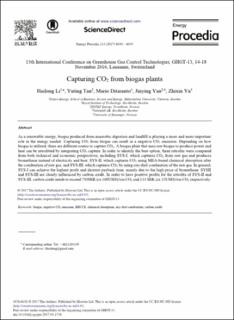| dc.contributor.author | Li, Hailong | |
| dc.contributor.author | Tan, Y | |
| dc.contributor.author | Ditaranto, Mario | |
| dc.contributor.author | Yan, Jinying | |
| dc.contributor.author | Yu, Zhixin | |
| dc.date.accessioned | 2021-08-19T09:15:49Z | |
| dc.date.available | 2021-08-19T09:15:49Z | |
| dc.date.created | 2017-08-21T13:45:21Z | |
| dc.date.issued | 2017-07 | |
| dc.identifier.citation | Li, H., Tan, Y., Ditaranto, M. et al. (2017) Capturing CO2 from Biogas Plants. Energy Procedia, 114, pp. 6030-6035. | en_US |
| dc.identifier.issn | 1876-6102 | |
| dc.identifier.uri | https://hdl.handle.net/11250/2770246 | |
| dc.description.abstract | As a renewable energy, biogas produced from anaerobic digestion and landfill is playing a more and more important role in the energy market. Capturing CO2 from biogas can result in a negative CO2 emission. Depending on how biogas is utilized, there are different routes to capture CO2. A biogas plant that uses raw biogas to produce power and heat can be retrofitted by integrating CO2 capture. In order to identify the best option, three retrofits were compared from both technical and economic perspectives, including SYS-I, which captures CO2 from raw gas and produces biomethane instead of electricity and heat, SYS-II, which captures CO2 using MEA-based chemical absorption after the combustion of raw gas, and SYS-III, which captures CO2 by using oxy-fuel combustion of the raw gas. In general, SYS-I can achieve the highest profit and shortest payback time, mainly due to the high price of biomethane. SYSII and SYS-III are clearly influenced by carbon credit. In order to have positive profits for the retrofits of SYS-II and SYS-III, carbon credit needs to exceed 750SEK (or 100USD)/ton CO2 and 113 SEK (or 15USD)/ton CO2 respectively. | en_US |
| dc.language.iso | eng | en_US |
| dc.publisher | Elsevier Ltd. | en_US |
| dc.rights | Attribution-NonCommercial-NoDerivatives 4.0 Internasjonal | * |
| dc.rights.uri | http://creativecommons.org/licenses/by-nc-nd/4.0/deed.no | * |
| dc.subject | karbonfangst | en_US |
| dc.subject | biogass | en_US |
| dc.title | Capturing CO2 from Biogas Plants | en_US |
| dc.type | Peer reviewed | en_US |
| dc.type | Journal article | en_US |
| dc.description.version | publishedVersion | en_US |
| dc.rights.holder | © 2017 The Authors. | en_US |
| dc.subject.nsi | VDP::Teknologi: 500 | en_US |
| dc.subject.nsi | VDP::Matematikk og Naturvitenskap: 400::Basale biofag: 470 | en_US |
| dc.source.pagenumber | 6030-6035 | en_US |
| dc.source.volume | 114 | en_US |
| dc.source.journal | Energy Procedia | en_US |
| dc.identifier.doi | 10.1016/j.egypro.2017.03.1738 | |
| dc.identifier.cristin | 1487653 | |
| dc.relation.project | Norges forskningsråd: 193816 | en_US |
| cristin.unitcode | 217,8,6,0 | |
| cristin.unitname | Institutt for petroleumsteknologi | |
| cristin.ispublished | true | |
| cristin.fulltext | original | |
| cristin.qualitycode | 1 | |

